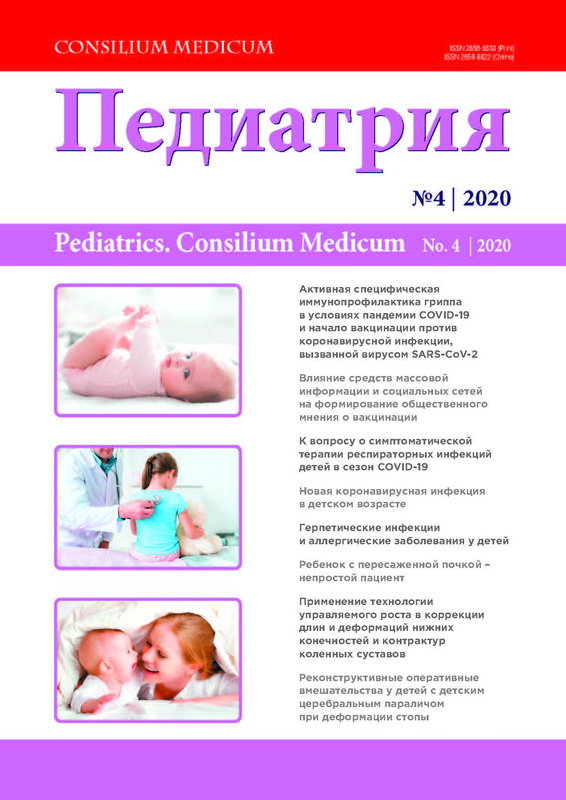Possibilities of using topical (intranasal) solution of framycetin in the treatment of inflammatory pathology of the nasal cavity and nasopharynx in children 3–9 years old
- 作者: Bogomil’skii M.R.1, Radtsig E.I.1,2, Pivneva N.D.1
-
隶属关系:
- Pirogov Russian National Research Medical University
- Morozov Children’s City Clinical Hospitall
- 期: 编号 4 (2020)
- 页面: 38-43
- 栏目: Articles
- URL: https://pediatria.orscience.ru/2658-6630/article/view/62507
- DOI: https://doi.org/10.26442/26586630.2020.4.200468
- ID: 62507
如何引用文章
全文:
详细
Relevance. Topical antimicrobial agents (TAAs) have been used for many years to treat infections of various organs and systems, acting directly at the site of inflammation and providing a high local concentration in the absence of side/undesirable effects often associated with the use of systemic antibacterial agents. TAAs are included in the clinical guidelines of professional medical communities not only in combination with systemic antibacterial agents, but also as an alternative method of treatment (especially in otorhinolaryngology).
Aim. To evaluate the clinical efficacy of a solution for intranasal use based on framycetin of Russian (Tramicent®) and foreign (Isofra®) production in the complex therapy of patients with rhinopharyngitis and rhinosinusitis.
Materials and methods. The study included children aged 3 to 9 years who applied for an outpatient appointment with an otorhinolaryngologist for nasal congestion and/or discharge and did not require hospitalization for the underlying disease. All patients were prescribed treatment: sea water solutions for irrigation of the nasal mucosa in combination with intranasal TAA framycetin: Russian-made framycetin was used in children of group 1 (Tramicent®), in children of group 2 – foreign production (Isofra®). 7 days after the initial examination, the state of nasal breathing, rhinoscopic picture, dynamics of disease symptoms and satisfaction with the treatment of parents/legal representatives were assessed.
Results. The study included 61 patients aged 3 to 9 years (31 boys and 30 girls) with diagnoses of rhinopharyngitis (68%) and rhinosinusitis (32%). Comparison of the evaluated symptoms in patients on day 0 and day 7 showed that both drugs had a positive therapeutic effect: a statistically significant difference was noted in both groups for all studied symptoms on day 0 versus day 7 (p<0.05). Patients and/or their parents/legal representatives subjectively assessed the effectiveness of treatment with both drugs as “satisfied” and “very (very) satisfied”, no statistically significant difference was found (p=0.1987).
Discussion. The use of a Russian drug based on framycetin, in comparison with its foreign analogue, showed comparable clinical efficacy for all indicators evaluated in this study, with the exception of the symptom «nasal cavity edema». Subjective assessment of the treatment performed by parents/legal representatives of children also did not reveal a statistically significant difference in the use of framycetin produced in Russia and abroad (p=0.1987).
Conclusion. A Russian-made drug based on framycetin is not inferior in clinical efficacy to a foreign analogue, it is safe and can be used in treatment regimens for infectious and inflammatory pathologies of the nasal cavity and nasopharynx in children aged 3 to 9 years.
全文:
作者简介
Mikhail Bogomil’skii
Pirogov Russian National Research Medical University
Email: mirabo1934@mail.ru
ORCID iD: 0000-0002-3581-1044
D. Sci. (Med.), Prof., Corr. Memb. RAS
俄罗斯联邦, MoscowElena Radtsig
Pirogov Russian National Research Medical University; Morozov Children’s City Clinical Hospitall
编辑信件的主要联系方式.
Email: radtsig_e@rsmu.ru
ORCID iD: 0000-0003-4613-922X
D. Sci. (Med.), Prof.
俄罗斯联邦, MoscowNatalia Pivneva
Pirogov Russian National Research Medical University
Email: pivnevand@yandex.ru
ORCID iD: 0000-0003-3673-9272
Cand. Sci. (Med.)
俄罗斯联邦, Moscow参考
- Salomon J, Somme A, Bernde C et al. Antibiotics for nasopharyngitis are associated with a lower risk of office-based physician visit for acute otitis media within 14 days for 3- to 6-year-old children. J Eval Clin Pract 2008; 14 (4): 595–9. doi: 10.1111/j.1365-2753.2007.00927.x
- Клинические рекомендации НМАО «Острый синусит». СПб.: Полифорум-групп, 2016. http://www.nmaoru.org/files/KR313%20Ostryj%20sinusit.pdf [Clinical guidelines NMAO «Acute sinusitis». Saint Petersburg: Poliforum-grupp, 2016. http://www.nmaoru.org/files/KR313%20Ostryj%20sinusit.pdf (in Russian).]
- Miyake MM, Bleier BS. Future topical medications in chronic rhinosinusitis. Int Forum Allergy Rhinol 2019; 9 (S1): S32–46. doi: 10.1002/alr.22341
- Богомильский М.Р., Чистякова В.Р. Болезни уха, горла и носа в детском возрасте. Национальное руководство. Краткое издание. М.: ГЭОТАР-Медиа, 2015. [Bogomilsky M.R., Chistyakova V.R. Diseases of the ear, nose and throat in childhood. National leadership. Short edition. Moscow: GEOTAR-Media, 2015 (in Russian).]
- Пальчун В.Т. Оториноларингология. Национальное руководство. М.: ГЭОТАР-Медиа, 2016. [Palchun V.T. Otorhinolaryngology. National leadership. Moscow: GEOTAR-Media, 2016 (in Russian).]
- Богомильский М.Р., Радциг Е.Ю., Селькова Е.П. Болезни уха, горла и носа при ОРЗ у детей. М.: ГЭОТАР-Медиа, 2016. [Bogomilsky M.R., Radtsig E.Yu., Selkova E.P. Diseases of the ear, throat and nose with acute respiratory infections in children. Moscow: GEOTAR-Media, 2016 (in Russian).]
- Pandolfini C, Campi R, Clavenna A et al. Italian paediatricians and off-label prescriptions: Loyal to regulatory or guideline standards? Acta Paediatr 2007; 94 (6): 753–7. doi: 10.1111/j.1651-2227.2005.tb01976.x
- Pandolfini C, Bonati M. Off-label drug use in children in Europe: a major health issue. Pharm Dev Regul 2003; 1: 133–43.
- Conroy S, Choonara I, Impicciatore P et al. Survey of unlicensed and off label drug use in paediatric wards in European countries. European Network for Drug Investigation in Children. Br Med J 2000; 320: 79–82.
- Cuzzolin L, Zaccaron A, Fanos V. Unlicensed and off-label uses of drugs in paediatrics: a review of the literature. Fundam Clin Pharmacol 2003; 17: 125–31.
- Conroy S. Unlicensed and off-label drug use: issues and recommendations. Paediatr Drugs 2002; 4: 353–9.
- Schirm E, Tobi H, de Vries TW et al. Lack of appropriate formulations of medicines for children in the community. Acta Paediatr 2003; 92: 1486–9.
- Карпищенко С.А., Кривопалов А.А., Еремин С.А. и др. Топическая антимикробная терапия инфекционно-воспалительных заболеваний носа и околоносовых пазух. РМЖ. 2020; 1 (8): 1–7. [Karpishchenko S.A., Krivopalov A.A., Eremin S.A. et al. Topical antimicrobial therapy for infectious and inflammatory diseases of the nose and paranasal sinuses. RMJ. 2020; 1 (8): 1–7 (In Russian).]
补充文件







